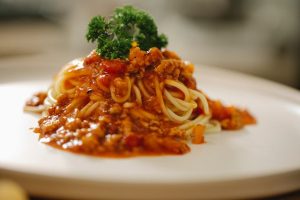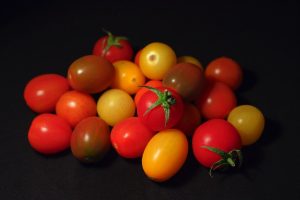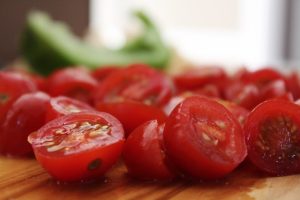
Introduction:
Meet Jane Anderson, a seasoned Home Economist with a passion for crafting delicious and nutritious recipes. With years of experience in blending flavors and maximizing the potential of each ingredient, she’s here to take you on a gastronomic adventure with her Tuna Pasta Salad recipe. Join Jane as she shares her expertise and unveils the secrets to creating a dish that’s not only bursting with freshness but also packed with garden goodness. Embark on your culinary adventure by embracing the garden-to-table philosophy. Home Economists emphasize the importance of using fresh, in-season ingredients. This approach enhances the flavors of your dishes and makes your Tuna Pasta Salad an unforgettable experience. When you use ingredients that are in-season, you’re guaranteeing the best possible flavor and nutritional value for your Tuna Pasta Salad. For example, tomatoes picked at the peak of ripeness from your local garden or farmer’s market will provide a burst of sweet, juicy goodness that you simply won’t find in off-season alternatives.

Symphony of Flavors
Jane Anderson reveals the secrets to selecting top-notch ingredients for your Tuna Pasta Salad. To start, she emphasizes the importance of choosing the right tuna. High-quality canned tuna or fresh tuna, if available, will make a world of difference in your salad. It should be tender and flavorful, not dry and bland. When it comes to vegetables and herbs, Jane suggests hand-picking the freshest options available. Vibrant, crisp vegetables like bell peppers, cucumbers, and red onions add a delightful crunch to your salad. Fresh herbs like basil, parsley, and dill infuse your dish with a burst of aromatic flavors. And let’s not forget about the pasta. The choice of pasta can significantly impact your Tuna Pasta Salad. A short pasta like penne or rotini is ideal, as it captures the dressing and other ingredients in every bite. Plus, it offers a pleasant chewiness that complements the other textures in the salad.
Perfect Dressing
The dressing is the heart of any salad. Learn from our expert how to balance flavors, incorporate herbs, and seasonings, and create a dressing that harmonizes the diverse ingredients in your Tuna Pasta Salad. Jane’s secret to a perfectly balanced dressing is to combine ingredients that cover the entire flavor spectrum. A splash of olive oil provides richness, while a squeeze of fresh lemon juice adds brightness and acidity. To enhance the flavors further, incorporate a touch of Dijon mustard for depth, and honey for a hint of sweetness. Fresh herbs like basil, parsley, and dill are essential for infusing your dressing with a burst of flavor. Jane advises finely chopping these herbs to ensure their flavor is evenly distributed throughout the dressing. Add a pinch of salt and a grind of black pepper to taste.
Tantalizing Taste
Jane shares her techniques for cooking pasta to perfection, marinating the salad ingredients, and making the tuna shine. Your taste buds are in for a treat!
When it comes to cooking pasta for your Tuna Pasta Salad, Jane recommends boiling it until it’s al dente, meaning it’s firm to the bite. Overcooked pasta can become mushy in the salad, so pay close attention to the cooking time recommended on the pasta package.
Marinating the salad ingredients is an essential step to infuse flavors throughout the dish. Jane suggests allowing the cooked pasta to cool and tossing it with a few tablespoons of the dressing while it’s still warm. This allows the pasta to absorb the flavors. Then, marinate the salad in the refrigerator for at least an hour or longer, if possible, to let the ingredients meld together.
Tuna is the star of the show in this dish, and Jane has some tips for ensuring it shines. Gently flake the tuna into bite-sized pieces to distribute it evenly throughout the salad. Taste as you go to adjust the seasoning and dressing, ensuring a harmonious blend of flavors.

Serving and Savoring:
Presentation matters, and our Home Economist shows you how to elevate your dining experience. Explore pairing options to complement your Tuna Pasta Salad.
To truly savor your Tuna Pasta Salad, presentation is key. A visually appealing dish not only stimulates your appetite but also makes the dining experience more enjoyable. Use a clear, glass serving dish or bowl to showcase the vibrant colors of your salad.
Consider adding a final touch of freshly chopped herbs, a few extra twists of black pepper, or a sprinkle of grated Parmesan cheese for extra flavor and visual appeal.
When it comes to serving your Tuna Pasta Salad, you have several options. It can be enjoyed as a standalone meal, a side dish, or even as a picnic or potluck contribution. Pairing options are versatile, too. A glass of crisp white wine, a crusty baguette, or a simple green salad can complement the flavors of your Tuna Pasta Salad.
Perspective
Beyond taste, understand the health benefits of your creation. Jane delves into the nutritional aspects and offers customization options to suit your dietary preferences.
Tuna Pasta Salad isn’t just about taste; it also packs a nutritional punch. Tuna is a fantastic source of protein and heart-healthy omega-3 fatty acids. The abundance of vegetables and herbs in the salad provides essential vitamins and antioxidants.
Customization is a wonderful aspect of this dish. You can easily adapt it to your dietary preferences. For a lighter version, use whole wheat pasta and reduce the amount of olive oil in the dressing. To boost the protein content, consider adding some white beans or chickpeas. Jane encourages you to make the dish your own.
KeyPoint:
| Key Points | |
|---|---|
| Garden-to-Table Approach | The importance of seasonal ingredients. |
| Enhancing flavor with freshness | |
| Ingredients: A Symphony of Flavors | Choosing high-quality tuna |
| Selecting fresh vegetables and herbs | |
| Picking the right pasta | |
| Preparing the Perfect Dressing | Achieving flavor balance |
| Incorporating herbs and seasonings | |
| Techniques for Tantalizing Taste | Cooking pasta to perfection |
| Marinating ingredients for flavor | |
| Tuna tips for optimal taste | |
| Assembling Your Masterpiece | Layering ingredients for visual appeal |
| Balancing textures | |
| Presentation tips | |
| Serving and Savoring | Elevating the dining experience |
| Pairing options for a complete meal | |
| A Nutritional Perspective | Health benefits of the Tuna Pasta Salad |
| Customization options for dietary needs |
Conclusion:
In this culinary journey, you’ve not only learned to create a mouthwatering Tuna Pasta Salad but also gained insights from Home Economists to elevate your kitchen skills. Jane Anderson, our seasoned author, has guided you through every step, ensuring that your Tuna Pasta Salad is a delectable delight. So, let’s get started on this fresh and flavorful adventure! Whether you’re preparing it for a family dinner, a potluck, or a picnic, your Tuna Pasta Salad will undoubtedly become a beloved dish, a testament to your culinary prowess. The garden-fresh goodness, balanced flavors, and nutritional benefits are sure to impress your guests and tantalize your taste buds. Now, it’s time to don your apron, grab your ingredients, and embark on this delightful culinary journey. Enjoy your Fresh and Flavorful Tuna Pasta Salad with Garden Goodness!






















